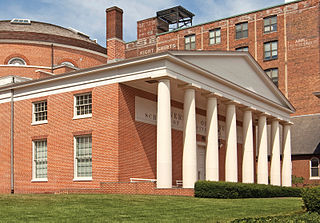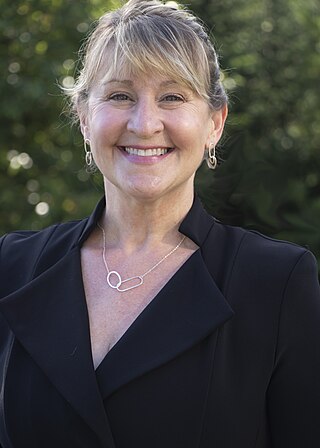Related Research Articles

The Chesapeake Bay is the largest estuary in the United States. The Bay is located in the Mid-Atlantic region and is primarily separated from the Atlantic Ocean by the Delmarva Peninsula, including parts of the Eastern Shore of Maryland, the Eastern Shore of Virginia, and the state of Delaware. The mouth of the Bay at its southern point is located between Cape Henry and Cape Charles. With its northern portion in Maryland and the southern part in Virginia, the Chesapeake Bay is a very important feature for the ecology and economy of those two states, as well as others surrounding within its watershed. More than 150 major rivers and streams flow into the Bay's 64,299-square-mile (166,534 km2) drainage basin, which covers parts of six states, New York, Pennsylvania, Delaware, Maryland, Virginia, and West Virginia, and all of Washington, D.C.

The Patuxent River is a tributary of the Chesapeake Bay in the state of Maryland. There are three main river drainages for central Maryland: the Potomac River to the west passing through Washington, D.C., the Patapsco River to the northeast passing through Baltimore, and the Patuxent River between the two. The 908-square-mile (2,352 km2) Patuxent watershed had a rapidly growing population of 590,769 in 2000. It is the largest and longest river entirely within Maryland, and its watershed is the largest completely within the state.

The University of Maryland, Baltimore (UMB) is a public university in Baltimore, Maryland. Founded in 1807, it comprises some of the oldest professional schools of dentistry, law, medicine, pharmacy, social work and nursing in the United States. It is the original campus of the University System of Maryland and has a strategic partnership with the University of Maryland, College Park. Located on 71 acres (0.29 km2) on the west side of downtown Baltimore, it is part of the University System of Maryland.

The Smithsonian Environmental Research Center (SERC) is a United States 2,650-acre (10.7 km2) environmental research and educational facility operated by the Smithsonian Institution. It is located on the Rhode and West Rivers near Edgewater in Anne Arundel County, Maryland, near the western shore of Chesapeake Bay. The center's focus of study is the ecosystems of coastal zones, particularly in the Chesapeake Bay estuary and nearby wetlands.
The Chesapeake Biological Laboratory (CBL) is a marine science laboratory on the Chesapeake Bay in Solomons, Maryland, and it is the oldest state-supported marine laboratory on the East Coast of the U.S. It was founded in 1925 in a small waterman's shack by Dr. Reginald V. Truitt and is part of the University of Maryland Center for Environmental Science.

The Jug Bay Wetlands Sanctuary is located along the tidal Patuxent River in southern Maryland, United States. It was established in 1985 and is operated by the Anne Arundel County Department of Recreation and Parks. It includes more than 1,700 acres (6.9 km2) of tidal freshwater wetlands, forests, meadows and fields. The wetlands, with large stands of aquatic plants including wild rice, are home to many birds, fish, reptiles, amphibians, and mammals. Miles of trails and boardwalks traverse a variety of habitats and provide glimpses into the rich history of the region. Notably, archaeologists have uncovered evidence of a large Native American settlement at Jug Bay which spanned 2 miles along the Patuxent, with the oldest arrowhead-like artifact dated between 8,000 to 8,900 years old.
The Chesapeake Bay National Estuarine Research Reserve is an estuary reserve in Maryland.
The University of Maryland School of Public Policy is one of 14 schools at the University of Maryland, College Park. The school is located inside the Capital Beltway.

Richard Robert "Ricky" Arnold II is an American educator and a NASA astronaut. He flew on Space Shuttle mission STS-119, which launched March 15, 2009, and delivered the final set of solar arrays to the International Space Station. He launched again in 2018 to the ISS, onboard Soyuz MS-08.
Gilbert Clarence Klingel (1908–1983) was a naturalist, boatbuilder, adventurer, photographer, author, inventor, contributor to the Baltimore Sun, for a time affiliated with the American Museum of Natural History in New York and a member of the Maryland Academy of Sciences, and a curator and charter member of the Natural History Society of Maryland. He is best known for his book about the Chesapeake Bay, The Bay, which won the John Burroughs Medal in 1953.

The Virginia Institute of Marine Science (VIMS) is one of the largest marine research and education centers in the United States. Founded in 1940, VIMS is unique among marine science institutions in its legal mandate to provide research, education, and advisory services to government, citizens, and industry. Funding for VIMS comes from the Commonwealth of Virginia, grants and contracts from federal and state agencies, and private giving. The School of Marine Science (SMS) at VIMS is the graduate school in marine science for the College of William & Mary. VIMS offers M.S., Ph.D., and professional M.A. degrees in marine science. The school has 52 faculty members, an enrollment of 80-100 students, and includes 4 academic departments. VIMS' main campus is located in Gloucester Point, Virginia.

Reginald Van Trump Truitt was an American zoologist, Army officer, and college lacrosse player and coach. He spent his professional career studying the oyster habitat in the Chesapeake Bay. Truitt founded the Chesapeake Biological Laboratory at what is now the University of Maryland Center for Environmental Science. He also served as the first head lacrosse coach at his alma mater, the University of Maryland from 1919 to 1927. Truitt was inducted into the National Lacrosse Hall of Fame in 1959.
Donald F. Boesch is a professor of marine science and, from 1990 to 2017, president of the University of Maryland Center for Environmental Science. From 2006-2017, he concurrently served as Vice Chancellor for Environmental Sustainability for the University System of Maryland. In 2010, he was appointed by President Barack Obama as a member of the National Commission on the BP Deepwater Horizon Oil Spill and Offshore Drilling to investigate the root causes of the blowout at the Macondo Prospect in the Gulf of Mexico.
The University of Maryland College of Agriculture and Natural Resources is the agricultural and environmental sciences college of the University of Maryland and operates the Maryland Sea Grant College in cooperation with the University of Maryland Center for Environmental Science and the National Oceanic and Atmospheric Administration.
RV Rachel Carson is a research vessel owned and operated by the University of Maryland's Center for Environmental Science, named in honor of the marine biologist and writer Rachel Carson.

Denise Breitburg is an American marine ecologist specializing in the effects of deoxygenation on marine systems and organisms such as oysters and jellyfish. She is Scientist Emeritus, at the Smithsonian Environmental Research Center (SERC).
The College of Computer, Mathematical, and Natural Sciences (CMNS) at the University of Maryland, College Park, is home to ten academic departments and a dozen interdisciplinary research centers and institutes. CMNS is one of 13 schools and colleges within the University of Maryland, College Park.
Margaret A. Palmer is a Distinguished University Professor in the Department of Entomology at the University of Maryland and director of the National Socio-Environmental Synthesis Center (SESYNC). Palmer works on the restoration of streams and rivers, and is co-author of the book Foundations of Restoration Ecology. Palmer has been an invited speaker in numerous and diverse settings including regional and international forums, science-diplomacy venues, and popular outlets such as The Colbert Report.

Deborah Ann Bronk is an American oceanographer and the president and CEO of Bigelow Laboratory for Ocean Sciences. She leads the nonprofit research institution in East Boothbay, Maine in its mission to understand the ocean's microbial engine and to harness the potential of these and other organisms at the base of the ocean food web through research, education, and innovation.
References
- ↑ Condon, Christine (2021-06-22). "University of Maryland scientists give the Chesapeake Bay a C on health report". The Baltimore Sun.
- ↑ Condon, Christine (2023-07-21). "Maryland Gov. Wes Moore launches new Chesapeake Bay strategy with a pair of executive orders during Eastern Shore tour". The Baltimore Sun.
- ↑ Prudente, Tim (2019-04-02). "Maryland's climate will become more like Mississippi's, researcher finds". The Washington Post.
- ↑ Dance, Scott (2016-09-20). "Longtime director of University of Maryland Center for Environmental Science stepping down". The Baltimore Sun.
- ↑ "How to Apply". University of Maryland Center for Environmental Science. 2016-11-22. Retrieved 2024-02-08.
- ↑ "Institute of Marine & Environmental Technology". University of Maryland Center for Environmental Science. 2016-10-04. Retrieved 2024-02-08.
- ↑ "Sea Grant | University of Maryland Extension". extension.umd.edu. Retrieved 2024-02-08.
- ↑ "Maryland Sea Grant". www.mdsg.umd.edu. Retrieved 2024-02-08.
- ↑ "What We Do". Integration and Application Network. Cambridge, MD: University of Maryland Center for Environmental Science. Retrieved 2023-09-02.